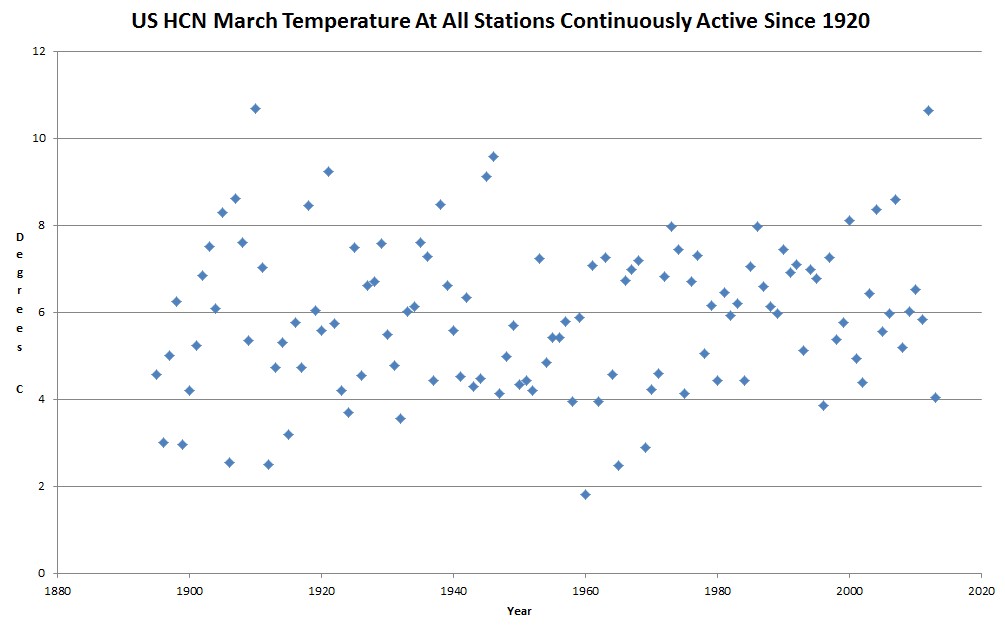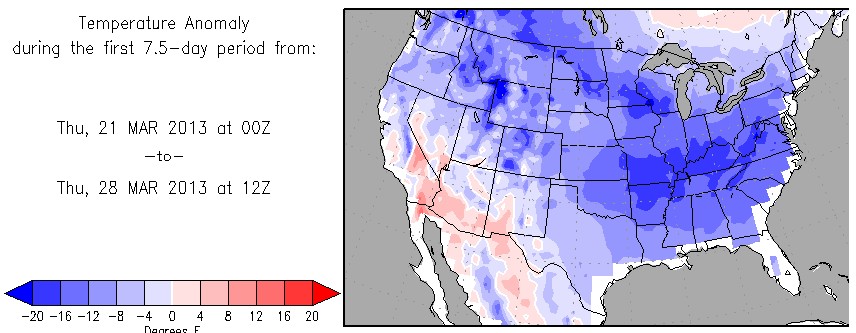US temperatures are forecast to be far below normal for the rest of the month, so it is difficult to determine where March 2012 will end in the rankings. Possibly the coldest in 44 years.
Disrupting the Borg is expensive and time consuming!
Google Search
-
Recent Posts
- Fact Checking NASA
- Fact Checking Grok
- Fact Checking The New York Times
- New Visitech Features
- Ice-Free Arctic By 2014
- Debt-Free US Treasury Forecast
- Analyzing Big City Crime (Part 2)
- Analyzing Big City Crime
- UK Migration Caused By Global Warming
- Climate Attribution In Greece
- “Brown: ’50 days to save world'”
- The Catastrophic Influence of Bovine Methane Emissions on Extraterrestrial Climate Patterns
- Posting On X
- Seventeen Years Of Fun
- The Importance Of Good Tools
- Temperature Shifts At Blue Hill, MA
- CO2²
- Time Of Observation Bias
- Climate Scamming For Profit
- Climate Scamming For Profit
- Back To The Future
- “records going back to 1961”
- Analyzing Rainfall At Asheville
- Historical Weather Analysis With Visitech
- “American Summers Are Starting to Feel Like Winter”
Recent Comments
- Bob G on Fact Checking NASA
- arn on Fact Checking NASA
- Gordon Vigurs on Fact Checking NASA
- Bob G on Fact Checking NASA
- Bob G on Fact Checking NASA
- arn on Fact Checking NASA
- conrad ziefle on Fact Checking NASA
- conrad ziefle on Fact Checking NASA
- arn on Fact Checking NASA
- Bob G on Fact Checking NASA




Hi Steven! We have snow too. We had snow then it got warm a little? and the snow melted a little bit? then it snowed again and now it’s getting warm and the snow is melting again, but there’s a little bit coming down from the sky. We call it spring. I like snow.
Hey dude, u coming over? I’ve got several fun posts just for u!
Sorry, I don’t surf potential malware sites.
How will Hansen ‘adjust’ this and with what color…or, hang on, he hasn’t done Feb yet either…
Steve,
You may well find this report called Temporal and Spatial Characteristics of Snowstorms in the Contiguous United States from American Meteorological Society.
I think Figures 4 and 8 is quite interesting, weather appears to be cyclic – who knew?
http://journals.ametsoc.org/doi/full/10.1175/JAM2395.1
The 1969 ‘Lindsay Snowstorm’
From February 8-10, 1969, a slow moving nor’easter pummeled the northeast United States. The storm began as a low pressure area moved across the central US on February 8. A secondary low formed over the southeast US on February 9. This second area of low pressure, which would eventually become the nor’easter, rapidly intensified. The central pressure of the low dropped 32 millibars in 18 hours, and eventually reached a low of 970 millibars. As the storm moved up the US east coast, it brought heavy snowfall and blizzard conditions to a large swath of the Northeast. Ninety-four people died during the storm.
Forecast models underestimated the severity of the storm, resulting in many of the areas it affected being woefully underprepared. The February 9 forecast for New York City called for snow changing over to rain. Instead, the city received 15 inches of snow. Similar amounts of snow fell throughout the Northeast; Bangor, Maine recorded 42 inches of snow during the event. In addition to the heavy snowfall, the storm brought winds of up to 45 mph and tides of up to three feet above normal to the areas it affected.
New York City was especially hard hit, as 42 people in the city died during the storm. In general, the city was not properly prepared to deal with the nor’easter. Almost 40 percent of the city’s snow equipment was broken as a result of poor maintenance, and the city’s emergency manager was not in town when the storm hit. The city’s transportation infrastructure was essentially brought to a halt for two full days; some areas were not plowed for a full week. Schools were cancelled throughout the city, and the storm forced the first ever weather-related closure of the New York Stock exchange.
Not only was the storm devastating, but it served as an early example of the potential political consequences of disasters in the United States. The poor response to the storm brought heavy criticism for the New York City’s mayor, John Lindsay. Lindsay contributed to the city’s anemic response to the storm by being budget-conscious. There were rumors that sanitation workers did not plow parts of the city because of their dislike of the mayor. The “Lindsay Snowstorm” weakened the mayor’s political position considerably, and he was unable to win his party’s nomination for mayor in the next election.
From http://webra.cas.sc.edu/hvri/feature/feb2013_notw.aspx
A similar situation in the UK.
It may be the coldest March since 1970 if things go on they way they have been.
Would some climatologist please clean up the Papa Smurf stain on the map? I can’t see the warming behind it.
Ha Ha….I know, right……I mean….you aweful denier!
As Ray says, March in the UK is running as the coldest since 1970.
http://notalotofpeopleknowthat.wordpress.com/2013/03/18/uk-headed-for-coldest-march-since-1970/
There’s no prospect of temperatures picking up before Monday at the earliest.